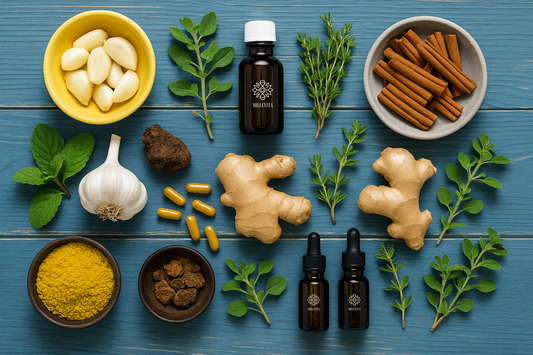
Oxalates Unlocked: Enjoy Your Greens Without the Guilt
Share
Table of Contents
Introduction
So you’ve sworn off processed junk and stocked your kitchen with kale smoothies, almond snacks and beetroot bowls—until someone warns you about oxalates. Oxal-what?
Don’t panic. Oxalates are simply plant-made compounds that can chelate minerals. They get a bad rap—often linked to kidney stones or nutrient blockages—but for most of us, they’re no big deal.
Let’s clear the chatter: who really needs to worry, which foods carry more of these little molecules, and how to enjoy a varied diet without drama.
What Are Oxalates?
Oxalates (a.k.a. oxalic acid) are naturally occurring in a wide array of plants. They function as part of a plant’s defence toolkit—nothing sinister, but not entirely inert either.
You’ll spot them in spinach, chard, almonds, beets—and yes, even in dark chocolate. Inside us, they can latch onto minerals like calcium or magnesium, sometimes forming crystals in the urinary tract.
Here’s a twist: your liver also churns out oxalates regardless of diet. So it’s not about zeroing them out, but about keeping them balanced.
Who Should Watch Out?
For most folks, oxalates aren’t a crisis—your body handles them just fine. But if any of these sound like you, a little caution can pay off:
- Kidney-stone veterans (especially calcium-oxalate types) should be mindful of oxalate load.
- High-volume plant eaters—vegans, vegetarians, green-juice addicts—who may be hitting high-oxalate ingredients daily.
- Gut-health challenges (IBD, IBS, malabsorption syndromes) that can amplify oxalate uptake.
Everybody else? Keep enjoying your veggies—just maybe don’t slam a kilo of spinach in one go.
Oxalate-Rich vs Oxalate-Light
Not all plants are equal on oxalates. Knowing which to moderate and which to lean on helps you diversify without overdoing it.
| High in Oxalates | Low to Moderate |
|---|---|
| Spinach, silverbeet, beetroot | Broccoli, cabbage, carrots |
| Sweet potato, rhubarb, okra | White potato, zucchini, pumpkin |
| Almonds, cashews, peanuts | Pumpkin & sunflower seeds |
| Dark chocolate, cocoa | Apples, bananas, melons |
| Black tea, soy protein | Eggs, dairy, meat, seafood |
It’s not about banning—just rotating so you don’t lean too heavily on the high-oxalate roster.
How to Keep Oxalates in Check
A kidney-stone scare? No thanks. Here are practical moves to limit crystal formation without turning mealtimes into math class:
💧 Stay Properly Hydrated
Aim for 2–3 L of fluid daily. Water dilutes urine and shoves oxalates out before they can crystallise.
🧂 Tame the Salt
High sodium spikes calcium excretion, which teams up with oxalates. Watch processed foods, sauces and take-aways.
🧀 Embrace Dietary Calcium
Calcium-rich foods bind oxalates in your gut. Think yoghurt, cheese or tofu made with calcium salts. If you need a supplement, citrate forms are gentler—ask your practitioner first.
🥩 Moderate Animal Protein
Lots of meat can acidify urine and drop citrate levels (citrate protects against stones). Balance with plant proteins to keep things neutral.
🍽️ Combine Strategically
Pair high-oxalate items with calcium-containing foods to trap oxalates before they’re absorbed.
Prep Tricks to Tame Oxalates
🔥 Boil Thoroughly
Boiling greens like spinach cuts oxalate content by over half. Toss the cooking water afterward.
💧 Soak Overnight
Give nuts, seeds and legumes an overnight soak to leach out extra oxalates.
🌫️ Steam Gently
Steaming trims some oxalates while keeping texture intact—a great middle ground.
🥫 Go Canned
Canned beans are pre-soaked & cooked, delivering lower oxalate levels and convenience.
Simple kitchen hacks that let you keep nutrient-packed foods in the mix without a side of worry.
When to Call in the Pros
Most of us don’t need a specialist every time we nibble spinach. But these red flags mean it’s time to book an appointment:
- Repeat kidney stones—especially calcium oxalate types.
- Restrictive diets (keto, vegan, detox)—to ensure you’re not unintentionally piling on oxalates or missing key nutrients.
- Chronic gut issues (IBS, IBD, malabsorption)—these can change how oxalates behave.
- Heavy supplement use—mega-doses of vitamin C or unbalanced calcium intake can backfire.
Your practitioner can tailor strategies—think probiotics, enzymes or binders—to your unique biochemistry.
Wrapping Up
Oxalates aren’t the villain they’re cracked up to be—most people process them just fine. But if you’ve had stones, eat huge plant loads or battle gut issues, a few mindful tweaks go a long way.
Drink well, balance calcium, dial back salt, and use simple cooking tricks. That’s the real recipe for enjoying a rich, plant-friendly diet without fear.
Disclaimer
This article is for general info only and not a substitute for personalised medical guidance. Always check with a qualified health professional before making diet or supplement changes—especially if you have existing conditions or take medications.
References
- National Kidney Foundation. Calcium-Oxalate Stones.
- Harvard T.H. Chan School of Public Health. Anti-Nutrients Overview.
- Medical News Today. Oxalic Acid Explained.
- RACGP. Citrate Salts for Stone Prevention.
- Kidney Health Australia. Types of Kidney Stones.



